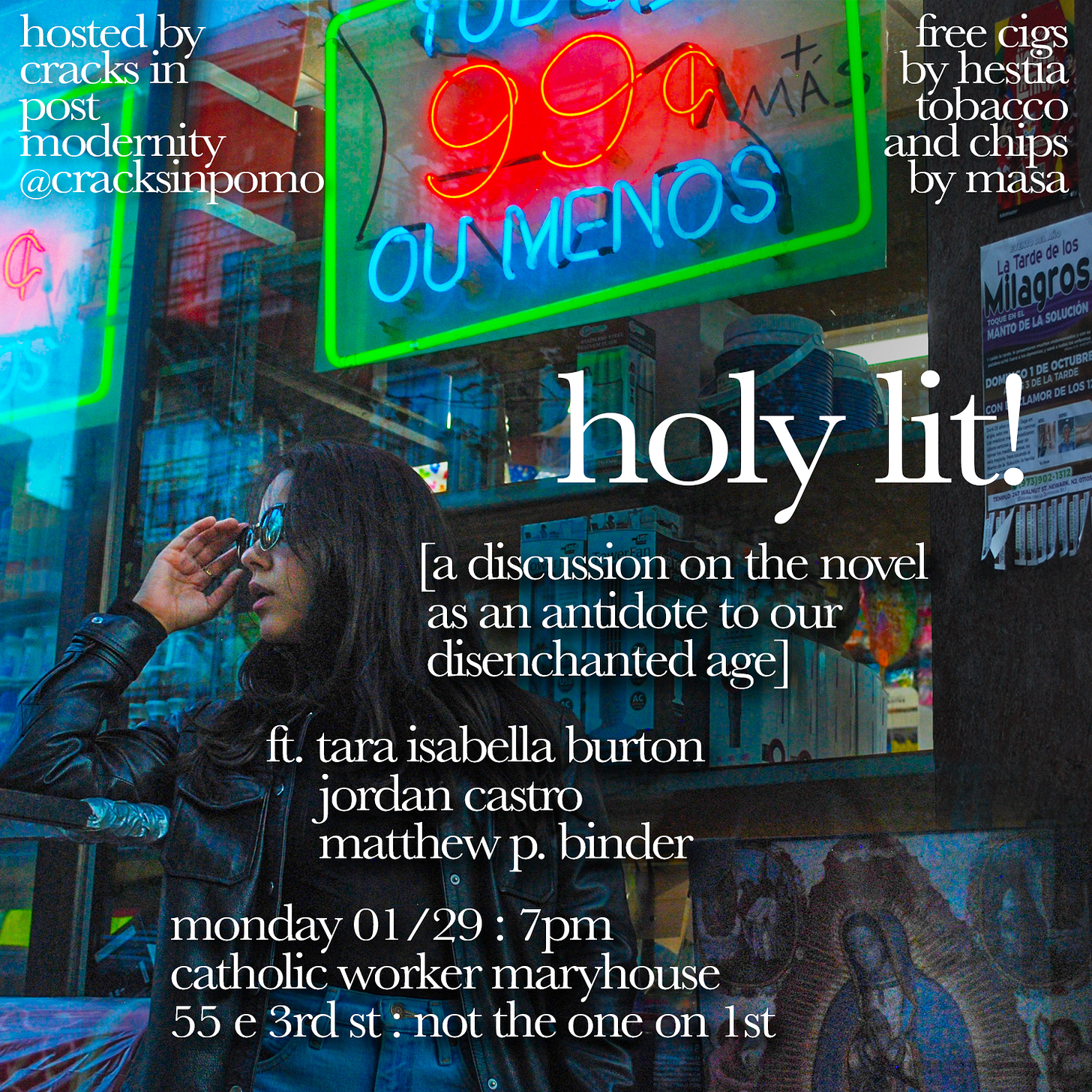You asked. We answered. Check out our first q+a pod:
Topics include Pentecostalism, doomscrolling, psychoanalysis, gay Taliban members, whether you should start a Substack, our top 10 films, and how much is too much. Also available on Spotify and Apple.
We hope you’ll join us on Monday 1/29 at Holy Lit!, a discussion on the novel as an antidote to our disenchanted age featuring Tara Isabella Burton, Jordan Castro, and Matthew P. Binder. More details here.
Also, check out my review of Tara’s latest novel Here in Avalon for Real Clear Books. Here’s an excerpt:
James Baldwin admits in his 1964 essay Nothing Personal to turning on the TV some mornings in order to distract himself from the frustrations the day would bring. He described the variety of commercials for products that defied natural biological realities to be “remarkable sights”: from women with dyed hair and grinning models with impossibly straight teeth, to glamorous middle-aged adults with wrinkle-free skin, and youth with “all conceivable body odor, under no matter what contingency, prevented for twenty-four hours of every day, forever and forever and forever.”
This flawless, odorless, picture-perfect ideal belongs to one of two “levels of experience” in the United States. One Baldwin describes as embodied in the pristine image of Gary Cooper and Doris Day, “two of the most grotesque appeals to innocence the world has ever seen”...which is to say, the America of Leave it to Beaver, the Weberian Protestant work ethic, sensible college students who major in STEM, and the predictability of algorithmic thinking.
The other America, embodied by Ray Charles, is “subterranean,” unkempt, decadent, and inevitably odorous. This side of the country fails to conceal the messy and unpredictable parts of human nature–both biologically and spiritually speaking.
Here In Avalon, Tara Isabella Burton’s third novel (and fifth book), is an exploration of this tension: between the “insane” and the “well-adjusted,” the secular and the enchanted, rationalistic and magical thinking, the self-selected and the gratuitously received.
Continue reading here.
Lastly, I published a piece in Catholic World Report on St. Stephen and martyrdom…inspired by my MA thesis.
Giussani claims that Stephen’s renunciation of his own life was, more than anything, a means to affirm his “friendship with Christ.” Moved less so by a sense of honor or duty, and more so by affection for a Person, a Presence, Stephen’s martyrdom “indicates to us his impassioned devotion to the Lord Jesus.”
He contextualizes the act of martyrdom within his formula for Christian morality, indicating that the act itself is the lived manifestation of (or adherence to) a person’s belief in the Person of Christ: “believing is not just trusting His words, but adhering to His Person, feeling His Person always present, mastering every activity of our life, every social relationship, even every form of thought and inner feeling.”
Continue reading here.
Please consider signing up for a paid subscription to this page for more riveting content. If you’re new to Cracks in Pomo, check out the About page or read up on our Essentials. Also check out our podcast on Spotify, Apple, and YouTube and follow us on Instagram and Twitter.
MASA tortilla chips by Ancient Crunch is offering our followers 10% off their order with the promo code CRACKSINPOSTMODERNITY. Click here to redeem.
Photo of The Martyrdom of St. Stephen by Kiko Arguello.




